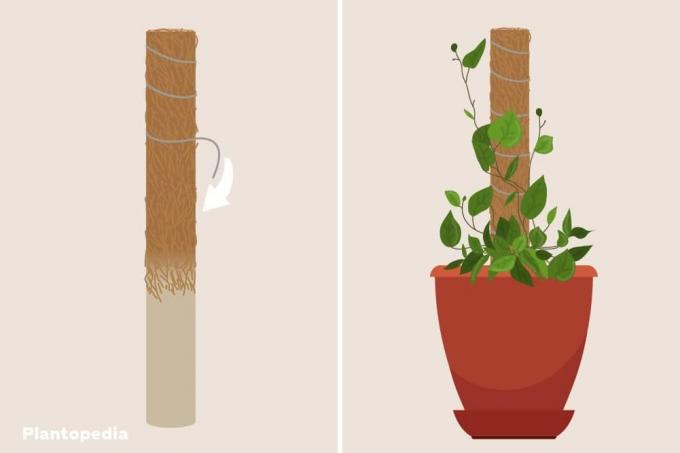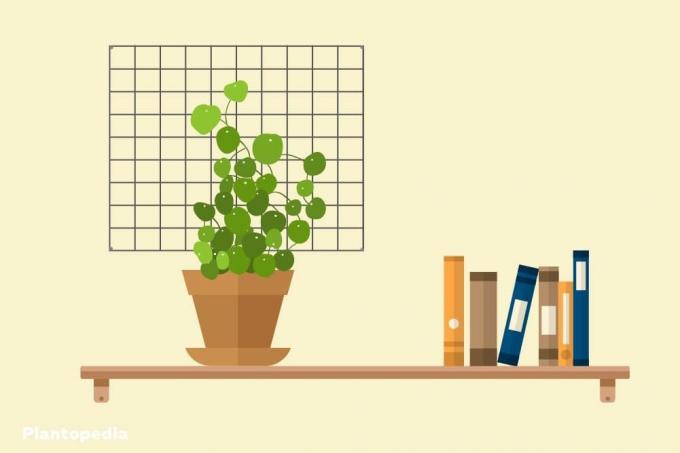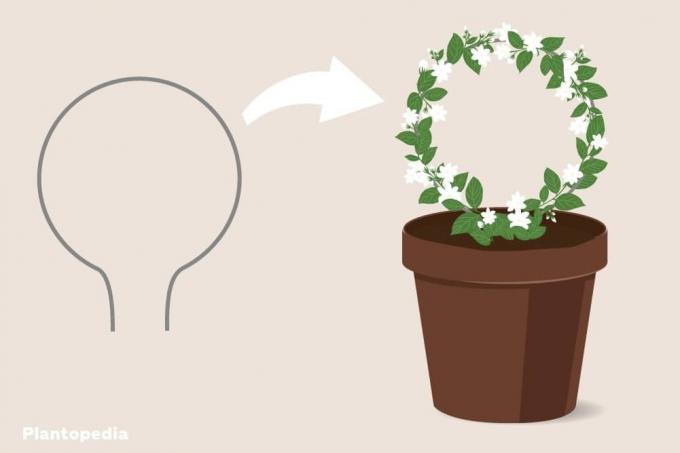
table of contents
- Simple stick
- Moss stick
- Instructions for wrapping
- Trellis with coconut fiber or jute
- Obelisk as a climbing aid
- Build a simple trellis
- Build stable trellis
- Offer the net as a stop
- Cord as a climbing aid
- Wall hook
- Archwires
- Gravity as a climbing aid
Some of the most beautiful houseplants are trailing specimens. In the great outdoors they find a suitable footing on their own. Mostly on trees in the rainforest, because they are predominantly tropical plants. There is no natural climbing aid available in our living rooms. The owner must provide stable support in good time and in a targeted manner. There are many possible solutions to this. With these instructions everyone can build a climbing aid themselves at low cost.
Simple stick
Small, upright houseplants can be supported very easily. Instructions are not even necessary for this. A sufficiently large and stable rod is sufficient. Some houseplants also need to be tied down. They either do not develop any organs of detention or they first need support until they can hold on to themselves. The tying also makes it possible to arrange the numerous tendrils of the plant according to your own wishes. Therefore you also need suitable fastening material. It should connect the tendrils firmly to the staff, but without constricting them.
- You can buy sticks in hardware stores and garden centers, e.g. B. made of plastic, metal or bamboo
- each in different sizes
- Fastening material is also available in stores
- however, any other available rod can be used
- however, the material must be able to withstand damp earth
- soft strips of fabric can serve as fastening material, e.g. B. of old, disused jeans
Insert the stick deep into the soil of the plant and then attach the tendrils to it. The simplest climbing aid is ready. If necessary, you can use several sticks as a climbing aid at the same time.
Tip: Think ahead when choosing the wand. The houseplant will grow, get bigger and heavier. Subsequent exchange of rods can mess up the shape or damage roots when inserting.
Moss stick
The moss stick is very popular as a climbing aid. There are reasons for that. In terms of its shape, it is also just a stick. But the layer of moss around it offers additional advantages. The soft moss is "gentle" to the roots of the plant. While it is difficult to get hold of smooth rods, the moss layer can be deeply rooted. A moss stick also blends harmoniously into the overall picture. With our instructions you can build a moss stick yourself. You will need the following materials:
- a rod of the appropriate size
- sufficient sphagnum moss
- Fastening wire
- alternatively sturdy thread for wrapping around or a tear-proof and water-resistant cord made of jute
Tip: Use green lacquered winding wire to secure the moss to the rod. Due to this coloration, it is not noticeable under an equally green leaf dress. In addition, its coating prevents it from rusting. This is important because it will come into contact with a lot of moisture.
Instructions for wrapping

These are the individual steps with which you can build this climbing aid yourself:
- Moisten the moss because it will be easier to handle. Simply put it in water until it is soaked up with it.
- Bend one end of the wire so that you are holding a U with a side length of about 5 cm in your hand.
- Place the U over the tip of the wand, then wrap the wire around it several times.
- Now take some moss in your hand and squeeze out the water.
- Place the moss on the stick so that about 3 to 5 cm of it is well covered all around.
- Now wrap wire around it two or three times. Firmly so that the moss does not slip off later.
- Work your way up piece by piece until almost the entire stick is wrapped in moss. Leave out the end that will be stuck into the potting soil.
- Make a loop with the wire and then continue to wrap the wire around the rod.
- Cut the wire, leaving about 5 cm. Knot or Now twist the end with the loop you formed earlier. This means that the fastening can no longer loosen or loosen.
- Insert the moss stick into the soil of the houseplant and attach a few tendrils or tendrils. Aerial roots on it.
Tip: Spray the moss stick regularly with water. This gives the moss a nice shine and stimulates the growth of the aerial roots.
Trellis with coconut fiber or jute
In addition to moss, there are two other natural materials for wrapping climbing sticks: coconut fiber and jute. A combination of both materials is also welcome. The instructions for the moss stick already provide information on how to build this climbing aid. Only the moss is simply replaced by coconut fiber. Jute can be bought as a woven fabric and wrapped around the rod in several layers. Then this is fixed with jute thread. The jute fabric can also be wrapped around a bar with coconut fibers. This gives the coconut fiber additional hold and it also looks decorative.
Obelisk as a climbing aid
Several simple rods grouped into an obelisk or a pyramid shape result in a three-dimensional climbing shape. This is ideal for plants like ivy, which conquer the given shape from all sides.
- Insert three or four sticks into the flower pot, each close to the edge of the pot. The distances between the bars should be even.
- Bring the tips of the rods together so that they easily cross each other.
- Tie these tips tightly together.
- If you like, you can reinforce the bar construction horizontally with bars at several heights.

Build a simple trellis
Spreading indoor plants cannot be satisfied with a simple climbing aid. You need a stable trellis that can not only cope with the weight of the leaf mass, but also enables the plant to grow in an attractive manner. You can assemble the simplest trellis from several bars. Insert two long climbing sticks into the flower pots. There should be a greater distance between the two. Now take several shorter rods and attach them horizontally to the large rods. Each with a distance of 15 to 20 cm. You can use it to tie the tendrils of the houseplant.
Tip: The larger a plant is or becomes over time, the thicker and larger the sticks used must be. The material must also be selected to be sufficiently stable.
Build stable trellis
Some climbing houseplants can get very large over the years. They usually have a sufficiently large, permanent place in the house. They often stay there for a lifetime, or at least for many years. It is therefore advisable to build a stable and long-lasting climbing aid straight away. This must be screwed firmly to the wall so as not to tip over.
- Buy pre-cut metal grids in stores
- Wooden lattices can be built by yourself from wooden strips
- attach to the wall with spacers
- Tie up the tendrils of the plant

Offer the net as a stop
A network of sturdy cords can also be a good climbing aid for indoor plants and can also be easily built yourself. An efeutute, for example, can spread its numerous long tendrils in it. Where it makes sense to place the net depends on your houseplant and mounting options. A couple of wall hooks are sufficient for the attachment. All sufficiently stable networks can be used for this purpose. Of course, they also have to meet the visual requirements. Because such a net can hardly be used as a climbing aid without attracting attention.
Cord as a climbing aid
A cord hanging from the ceiling can function as a climbing staff. Tendrils of indoor plants can be attached to it. While a climbing rod sometimes does not find a firm footing in the ground, each cord can be securely attached to the ceiling or wall with a hook.
Wall hook
Some houseplants only need a small support here and there so that the tendrils do not sag under their own weight. A flexible climbing aid that grows together with the houseplant can be the solution here. It consists of hooks that are screwed to the wall behind as required. Individual tendrils can be tied to it with a loop. The good thing about this climbing aid is that it is quickly covered by the green and therefore hardly appears at all. The plant is held as if by an invisible hand.
Archwires
Wax flowers or jasmine, but also other plants, tend to be particularly decorative on round arches. You can easily build this form of climbing aid yourself from sturdy but flexible wire. You can use a trick to make the bow look nice and round.
- Obtain wire from the hardware store that is at least 2 mm in diameter. It has to be flexible, but not too soft, so that the bow remains dimensionally stable over the long term. A wire length of 1.2 m is sufficient for each small bend.
- Find a round bucket or large saucepan with a suitable diameter.
- Wrap the wire around the bucket to give it its round shape.
- Carefully move the archwire with both hands to the edge of the bucket and then loosen it completely.
- Use your hands to shape the two ends of the wire so that they can be inserted into the flower pot like small sticks.

Tip: If you use two or more arches per plant, you can poke them so that they together form a spherical shape.
Gravity as a climbing aid
Find an elevated location for your houseplant from which it can hang its tendrils following the law of gravity. Then there is no longer any need to offer her a climbing aid. Of course, this is not feasible with every houseplant. But plants with fine tendrils like ivy do not lose any of their beauty. Large specimens can even be used as room dividers.
